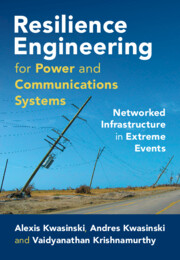 Resilience Engineering for Power and Communications Systems
Resilience Engineering for Power and Communications Systems Book contents
- Resilience Engineering for Power and Communications Systems
- Resilience Engineering for Power and Communications Systems
- Copyright page
- Contents
- Preface
- Acknowledgments
- 1 Introduction
- 2 Fundamental Supporting Concepts
- 3 Resilience Models and Metrics
- 4 Dependencies and Interdependencies and Their Effect on Resilience
- 5 Disaster Forensics of Infrastructure Systems
- 6 Electric Power Grid Resilience
- 7 Resilience of Information and Communication Networks
- 8 Integrated Electric Power and Communications Infrastructure Resilience
- 9 Infrastructure Systems Planning for Improved Resilience
- Index
- References
5 - Disaster Forensics of Infrastructure Systems
Published online by Cambridge University Press: 04 January 2024
- Resilience Engineering for Power and Communications Systems
- Resilience Engineering for Power and Communications Systems
- Copyright page
- Contents
- Preface
- Acknowledgments
- 1 Introduction
- 2 Fundamental Supporting Concepts
- 3 Resilience Models and Metrics
- 4 Dependencies and Interdependencies and Their Effect on Resilience
- 5 Disaster Forensics of Infrastructure Systems
- 6 Electric Power Grid Resilience
- 7 Resilience of Information and Communication Networks
- 8 Integrated Electric Power and Communications Infrastructure Resilience
- 9 Infrastructure Systems Planning for Improved Resilience
- Index
- References
Summary
As was introduced in Chapter 1, adaptation is a fundamental attribute of resilient systems. Adaptation could occur by identifying changes in the physical and social environment with the potential to affect a community system operation or by reacting after a disruptive event happens. Part of a positive reaction in the latter of these adaptation mechanisms involves learning about which factors contributed to improving resilience and which factors caused a lower resilience. This chapter focuses on an important tool that is part of such a learning process for improved resilience: disaster forensics. Disaster forensics are based on a postdisaster investigation, in which field investigations and postevent data collection are important components. Hence, the first part of this chapter will focus on explaining the steps and procedures involved with a disaster forensic investigation, including a description of how to perform field investigations. This chapter then describes power grids’ and information and communication networks’ performance in recent natural disasters based on lessons obtained during past forensic investigations.
- Type
- Chapter
- Information
- Resilience Engineering for Power and Communications SystemsNetworked Infrastructure in Extreme Events, pp. 195 - 275Publisher: Cambridge University PressPrint publication year: 2024


